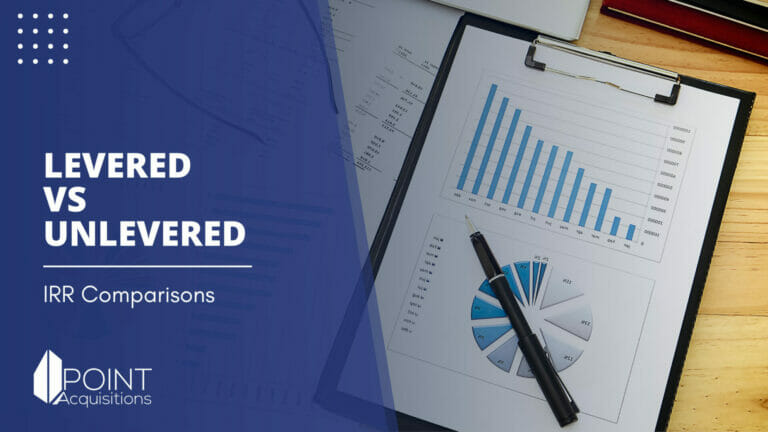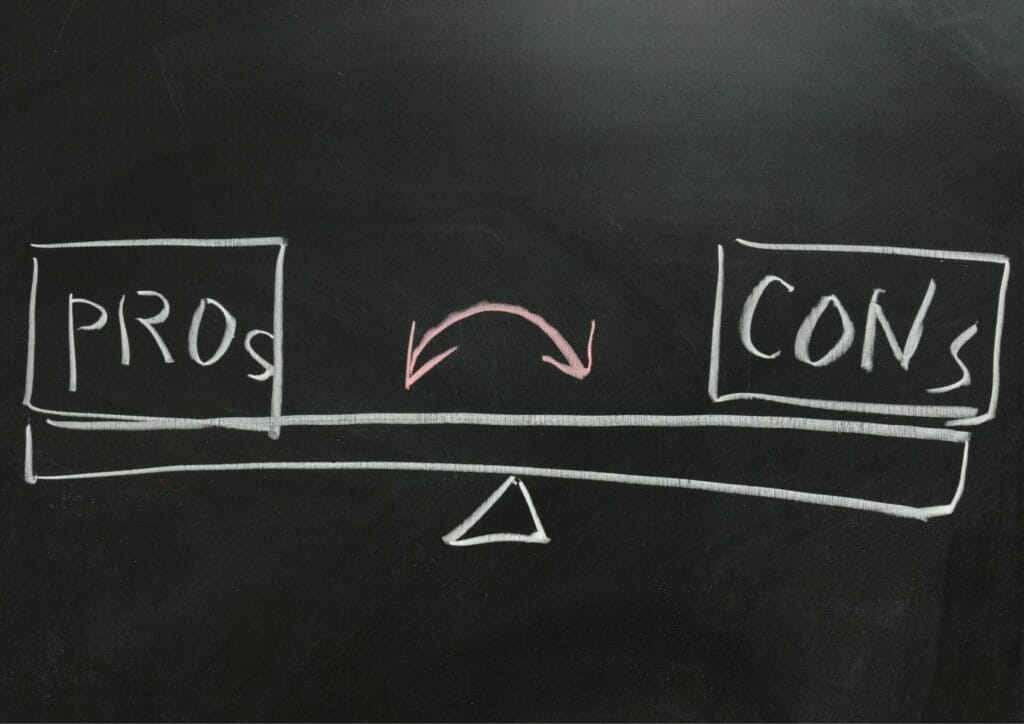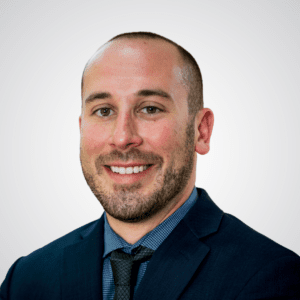
Maximizing Your CRE Returns: Levered vs Unlevered IRR Explained
As a commercial real estate seller or investor, you know that generating high returns is essential to your success. Understanding the Internal Rate of Return (IRR) concept is necessary. IRR is an important metric that helps you check the profitability of your commercial real estate investments.
However, with different approaches to calculating IRR, it can be challenging to know which method is best suited for your investment strategy.
In this post, we’ll explain the differences between levered vs. unlevered IRR and provide examples of how both methods can generate higher returns in commercial real estate investing. We’ll also discuss the advantages and disadvantages of each approach and explore real-world examples to help you make informed investment decisions.

Table of Contents
Importance of IRR in commercial real estate investing
IRR is a critical metric in commercial real estate investing as it measures an investment’s profitability over its holding period. It considers the time value of money and is a powerful tool for comparing different investment opportunities. Commercial real estate investors and sellers determine whether an investment will meet their financial goals and objectives by calculating the IRR.
IRR is also useful for assessing the risk involved in an investment.
- Higher IRR indicates a more profitable investment.
- Higher IRR may also mean higher risk.
- By considering both IRR and risk, investors can make better-informed decisions.
Another benefit of using IRR in commercial real estate investing is that it allows investors to determine the appropriate capital structure for their investments. Levered IRR and unlevered IRR is calculated based on different assumptions about an investment’s capital structure. Understanding the differences can help investors choose the right financing strategy to maximize their returns.
Overall, understanding the importance of IRR is crucial to successful commercial real estate investing. It helps investors to make informed decisions, check risk, and maximize investment returns.
Understanding Levered IRR and Unlevered IRR
When evaluating the profitability of commercial real estate investments, two types of Internal Rate of Return (IRR) are commonly used: levered IRR and unlevered IRR. These IRR measures are valuable tools in helping investors determine which investment opportunities offer the highest potential returns.
What is Levered IRR?
Levered IRR calculates the true return on investments with debt, factoring in loan costs. It’s necessary for assessing the real profitability of leveraged investments, guiding investors in making informed decisions about using debt to boost returns.
Levered IRR assumes that the investor has borrowed money to invest in the property and considers the interest payments associated with that borrowing.
What is Unlevered IRR?
On the other hand, unlevered IRR is a metric that only considers the investment’s return without any financing or debt included. Unlevered IRR represents the expected rate of return on investment if no financing was used. It only considers the cash flows generated by the investment itself.
Levered vs Unlevered IRR
When comparing levered vs unlevered IRR, it’s important to consider each approach’s potential benefits and drawbacks. Levered IRR can be more attractive in cases where the cost of borrowing is lower than the potential return on the investment.
However, leveraging an investment can also increase risk, as higher interest rates or other economic factors can negatively impact the returns on the investment.
Unlevered IRR can be a more conservative approach that is less reliant on debt, reducing the risk of an investment. However, it may also result in lower overall returns since there is no borrowing to boost the return on investment.
Ultimately, the choice between levered vs unlevered IRR will depend on various factors, including the investor’s risk tolerance, the cost of borrowing, and the specific investment details. By understanding the differences between the two, investors can make informed decisions about which IRR approach is best suited for their investment strategy.

Levered vs Unlevered IRR: Pros and Cons
Choosing between levered vs unlevered IRR is critical in commercial real estate investing. While both methods have advantages and disadvantages, there are certain situations where one approach may be more suitable.
When choosing between levered and unlevered IRR, it’s essential to consider the specific investment details, such as the property type, market trends, and the investor’s financial objectives. Investors should also consider their risk tolerance and the amount of available capital.
Let’s take a closer look at the differences between the two:
Levered IRR
- Positives
- Higher Potential Returns: This occurs when the cost of borrowing is lower than the potential return on the investment.
- Negatives
- Increased Risk: Leveraging an investment can increase risk, especially if higher interest rates or other economic factors negatively impact the returns.
Scenario: Investing in a Commercial Property
Step 1: Initial Investment
- Property Cost: $1,000,000
- Your Equity: $300,000 (30% of the property cost)
- Loan Amount: $700,000 (70% of the property cost)
Step 2: Financing
- Interest Rate on Loan: 5% per year
Step 3: Rental Income
- Annual Rental Income: $100,000
Step 4: Operating Expenses
- Annual Operating Expenses: $20,000 (not including loan payments)
Step 5: Loan Payments
- Annual Loan Payments (Principal + Interest): $50,000
Step 6: Net Operating Income
- Annual Net Operating Income: Rental Income – Operating Expenses – Loan Payments
- Calculation: $100,000 – $20,000 – $50,000 = $30,000
Step 7: Selling the Property
- After 5 years, you decide to sell the property.
- Sale Price: $1,200,000
- Loan Balance at Sale: $600,000
Step 8: Profit from Sale
- Profit: Sale Price – Remaining Loan Balance
- Calculation: $1,200,000 – $600,000 = $600,000
Step 9: Total Profit
- Total Profit over 5 Years: Net Operating Income over 5 years + Profit from Sale – Your Equity
- Calculation: ($30,000 * 5) + $600,000 – $300,000 = $450,000
Levered IRR Calculation
- The Levered IRR is the rate of return on your equity investment, considering the loan (leverage).
- In this scenario, you initially invested $300,000 and ended up with $450,000 after 5 years.
- The Levered IRR would be calculated based on these cash flows.
Unlevered IRR
- Positives
- Reduced Risk: It’s a more conservative approach, less reliant on debt, which reduces the risk of the investment.
- Negatives
- Lower Overall Returns: Since there is no borrowing to boost the return on investment, the overall returns might be lower.
Scenario: Investing in a Commercial Property Without Leverage
Step 1: Initial Investment
- Property Cost: $1,000,000
- Your Equity: $1,000,000 (100% of the property cost, no loan involved)
Step 2: Rental Income
- Annual Rental Income: $100,000
Step 3: Operating Expenses
- Annual Operating Expenses: $20,000 (covers maintenance, taxes, etc.)
Step 4: Net Operating Income
- Annual Net Operating Income: Rental Income – Operating Expenses
- Calculation: $100,000 – $20,000 = $80,000
Step 5: Selling the Property
- After 5 years, you decide to sell the property.
- Sale Price: $1,200,000
Step 6: Total Profit
- Total Profit over 5 Years: Net Operating Income over 5 years + Profit from Sale – Your Equity
- Calculation: ($80,000 * 5) + $1,200,000 – $1,000,000 = $600,000
Unlevered IRR Calculation
- The Unlevered IRR is the rate of return on your investment in the property, not considering any debt financing.
- In this scenario, you invested $1,000,000 and ended up with a total of $1,600,000 (including the sale) after 5 years.
- The Unlevered IRR would be calculated based on these cash flows.

Which IRR Measure is Best for You?
Choosing between levered vs unlevered IRR is challenging for commercial real estate investors. There are several factors that investors need to consider before selecting the appropriate IRR measure:
- The cost of borrowing
- market trends
- the investor’s risk tolerance
- the investment’s potential returns
Ultimately, the investor’s investment objectives and capital structure should also be considered when deciding which IRR measure best suits their investment strategy.
How to calculate both IRR measures
Both levered vs unlevered IRR can be calculated using a discounted cash flow (DCF) analysis. The DCF method uses cash flow projections to estimate the investment’s future cash flows. These are then discounted back to the present value using a discount rate. The resulting figure represents the IRR for the investment. To calculate levered IRR, the interest payments on the borrowed funds are also taken into account.
Common mistakes to avoid when calculating IRR
One of the most common mistakes made when calculating IRR is not properly accounting for the time value of money. Additionally, inaccurate IRR calculations can lead to:
- inconsistent cash flow projections
- miscalculating discount rates
- missing relevant cash flows.
It’s important to make sure that all cash flows are correctly accounted for and that the discount rate is appropriately applied.

Leveraging IRR for Maximized Returns
Leveraging IRR can be a valuable tool for investors looking to maximize their returns. Still, it’s essential to carefully evaluate the potential risks and rewards before deciding to leverage an investment. Investors should make sure that leveraging matches with their investment objectives and risk tolerance and are the appropriate strategy for their investment goals.
Explanation of how IRR can be leveraged to maximize returns
Leveraging IRR is an effective way to maximize returns in commercial real estate investing. Investors can increase their purchasing power by borrowing funds to invest and get more properties than they could without leveraging. Leverage can also increase the return on investment, as the borrowed funds can be used to generate more significant cash flows.
The role of leverage in commercial real estate investing
Leverage plays a significant role in commercial real estate investing, as it can provide investors with more significant investment opportunities and the potential for higher returns. However, it’s important to remember that borrowing to invest also comes with increased risk, and it’s important to carefully evaluate the potential risks and rewards before leveraging an investment.
The potential risks and rewards of using leverage to boost IRR
Using leverage to boost IRR can offer significant rewards, such as increased purchasing power and higher returns. However, it also comes with increased risks, such as higher interest rates, a potential for increased costs, and the potential for financial instability.
As such, it’s essential to carefully consider the potential risks and rewards of using leverage to maximize IRR and make sure that it suits the investor’s investment strategy and goals.
Conclusion
In summary, for commercial real estate investments, it’s essential to understand the differences between levered and unlevered IRR. Levered IRR offers potentially higher returns but with increased risk and borrowing costs. Unlevered IRR, being more conservative, suits risk-averse investors.
The choice depends on the investment’s specifics, market conditions, and the investor’s financial goals and risk tolerance. Accurate calculation and a clear strategy matching the investment objectives are key to effectively using IRR for maximizing returns.
FAQs
What exactly is leveraged IRR and how does it interact with annual cash flow in commercial real estate investments?
Leveraged IRR refers to the internal rate of return on a property when you use debt as part of the investment. It is calculated by taking into account the annual cash flow – the net income the property generates each year after expenses, including debt service.
This measure helps investors understand the profitability of a property considering the borrowed funds.
How important is my initial equity investment when calculating unleveraged IRR?
Your initial equity investment is important in determining unleveraged IRR. Since unleveraged IRR doesn’t consider borrowed funds, it solely focuses on the returns generated from your own invested capital.
The larger your initial investment, the more significant its impact on the overall unleveraged IRR of the property.
Can you explain the difference between levered cash flow and net cash flow in real estate investments?
Levered cash flow is a property’s income after accounting for financing costs, like mortgage payments. In contrast, net cash flow is the income from the property after all expenses, including operating costs and debt service, but before financing costs.
Levered cash flow gives a picture of the investment’s performance after considering debt, while net cash flow provides a broader overview of its overall financial health.
What is the process for calculating leveraged IRR in commercial real estate investments?
To calculate leveraged IRR, you’ll consider the cash flow generated from the property, including rental income minus operating expenses and financing costs. Then, factor in the sale proceeds at the end of your investment period.
Leveraged IRR is the rate that makes the net present value of these cash flows (both incoming and outgoing) equal to zero, taking into account the cost of borrowing.
Why is understanding the cash flow generated from a property crucial for leveraged IRR calculations?
Cash flow generated is a key component in leveraged IRR calculations as it directly influences the return on investment. The cash flow must cover debt obligations for leveraged properties while still providing a return.
The ability of a property to generate sufficient cash flow impacts the leveraged IRR, as it reflects the effectiveness of using borrowed funds in increasing investment returns.
About The Author

Jesse Shemesh
Disclaimer
Please note that Point Acquisitions is not a tax expert or tax advisor. The information on our blogs and pages is for general informational purposes only and should not be relied upon as legal, tax, or accounting advice. Any information provided does not constitute professional advice or create an attorney-client or any other professional relationship. We recommend that you consult with your tax advisor or seek professional advice before making any decisions based on the information provided on our blogs and pages. Point Acquisitions is not responsible for any actions taken based on the information provided on our blogs and pages.
1031 Exchange Capital Gains Tax Deferral
According to a 2021 report by the National Real Estate Exchange Services (RES), over 240,000 1031 exchange transactions were completed in the United States, totaling $100 billion. This impressive figure underscores the role of 1031 exchanges in the real estate…
Read More1031 Exchange Benefits
As of Q4 2023, the national vacancy rate for all commercial property types in the United States sat at 9.2%, according to CBRE’s latest insights and research. This represents a slight decrease compared to the previous quarter and suggests a…
Read More1031 Exchange Legal Considerations: A Must-Read Guide
You’re in the right place if you’re considering a 1031 exchange for your commercial real estate investments. Whether you’re a seasoned investor or just dipping your toes into the market, understanding the legal landscape of 1031 exchanges is key to…
Read More

